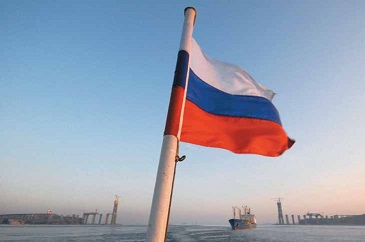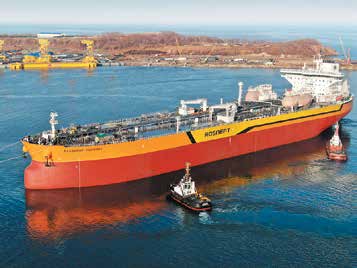 The demand for new domestically built commercial fleet was stabilized by Russian government through the state support measures. In 2019, Russian shipyards built 118 sea-going and inland vessels, which represents a 4% year-on-year growth.
The demand for new domestically built commercial fleet was stabilized by Russian government through the state support measures. In 2019, Russian shipyards built 118 sea-going and inland vessels, which represents a 4% year-on-year growth.
The Russian shipbuilding sector is one of the largest engineering industries in the country. The sector has a high scientific and technological potential, production capabilities influencing the development of technologies in the related industries. The shipbuilding sector of the Russian Federation includes about 600 enterprises: more than 90 naval architecture and marine engineering companies and R&D organizations, 180 shipyards and ship repair yards, as well as 310 marine components manufacturers. Most of the shipbuilding companies are integrated into the United Shipbuilding Corporation (USC). Over the nine-year period (2010-2019), in the framework of import substitution and local manufacturing content agenda, Russian shipyards have built 914 vessels and marine equipment facilities.
SHIPBUILDING BOOM
In 2019, Russian customers took delivery of 135 sea-going and inland vessels, with 118 units built at Russian shipyards (56 units under supervision of RS and 79 units under supervision of RRR), and only 17 ships were built at foreign shipyards.
A year earlier (2018), of a total 150 newbuilds (sea / river ships) 114 units were built at Russian and 36 — at foreign shipyards.
The above numbers show that the number of orders placed with domestic shipyards in 2019 increased 4% year-on-year (118 units), which indicates the positive effect of import substitution policy implemented in Russia.
In 2019, 41 vessels were built at domestic shipyards under supervision of the Russian Maritime Register of Shipping (RS), which is 12.2% more than a year earlier (36 vessels). Fifteen vessels were built at foreign shipyards, which represents a 42.3% drop from 2018 (26 vessels). Domestic shipyards built 77 vessels under supervision of Russian River Register (RRR) as compared with 78 units a year before. There was a slight decline in the number of domestically built vessels to the RRR class since most of owners opted for construction of sea-going and mixed (sea-river) class ships. In 2019 only a pair of commercial vessels were built at foreign shipyards to the class of RRR, which represents an 80% decrease year-on-year (10 vessels).
In 2019 Russian shipyards were busy with large civil shipbuilding projects. In particular, Alexeev’s Hydrofoil Design Bureau has delivered a pair of Valdai 45R hydrofoil vessels to fleet operator Vodolet. Vympel Shipyard has built second sea-going passenger hydrofoil of Project 23160 “Kometa 120M", for Mashpromlizing for further delivery under leaseback agreement to Sea Fast Passenger Services LLC. Baltiysky Shipyard has built the FPU Akademik Lomonosov. Yantar Baltic Shipyard completed the construction of two SK-3101R purse seiner/trawlers. Vyborg Shipyard has built Aker ARC124 (30044) harbor icebreaker. Amursky Shipyard has delivered 22420-series supply vessel. Nevsky Shipyard has delivered two salvage tugboats of MPSV12 design. Customers have taken delivery of eight dry cargo vessels of Project RSD59 from Krasnoye Sormovo Shipyard (7 newbuilds) and Nevsky Shipyard (1 unit).
Order intake at domestic shipyards continue to increase. The portfolio of current and future newbuilding orders includes the following segments: icebreaking vessels, fishing boats, high-speed / cruise passenger ships, inland vessels, offshore ships, and research vessels for various purposes.
MODERNIZATION INCENTIVES
The above newbuilding projects were successful thanks to state support provided by Russian Ministry of Industry and Trade.
As part of state support of the industry Russian government provides co-finance loan interest payment for the purchase of civil ships and leasing payments under leasing agreements concluded in 2009–2021. Currently 120 vessels are being subsidized, with 27 vessels received full amount of subsidies. Since 2017, the government has been providing to owners a ship recycling subsidy. This is a one-time payment to Russian shipping companies when decommissioning old fleet and placing newbuilding orders with domestic shipyard. The government has granted so far subsidies for the construction of 10 new ships. Another measure is the “Leasing Program for Sea-going and River Civil Vessels” implemented by leasing companies. As part of this program, funds were allocated for the construction of 82 ships.
For leasing projects, a financing scheme is used when the leasing companies enter into leasing agreements and shipbuilding contracts with shipowners and shipyards for the construction of commercial vessels on favorable terms.
In 2019, the Ministry of Industry and Trade of Russia began state support measures aimed at encouraging the construction of small and medium tonnage fishing vessels at the country’s shipyards.
Subsidies provided to shipowners to reimburse 30% of the cost of building a fishing vessel is yet another type of state support, but not more than the marginal cost specified in the government’s resolution. The subsidies are provided to customers who ordered new small and medium tonnage fishing vessels at Russian shipyards.
In addition, since this year Zvezda Shipyard will get subsidies for the construction of up to 15 LNG carriers ordered for Arctic LNG 2 and of MR product carriers powered by LNG. Subsidies for the Arctic LNG 2 gas carriers will be up to 20% of the construction cost specified in the contract, and for product tankers — up to 25% of the construction cost. Subsidies will be provided up front, in several stages, related to shipbuilding project milestones.
The first Russian Aframax tanker ever
 Zvezda Shipyard in May 2020 launched the first Russian Aframax tanker "Vladimir Monomakh".
Zvezda Shipyard in May 2020 launched the first Russian Aframax tanker "Vladimir Monomakh".
The new generation tanker is designed for ocean transportation of oil with unrestricted range of navigation. The vessel is designed in compliance with high environmental safety standards. The vessel’s propulsion main and auxiliary engines are powered by both conventional fuel oil and LNG.
Key particulars: length — 250 m, breadth — 44 m, DWT — 114 000 tonnes, speed — 14.6 knots, ICE-1A. Zvezda Shipyard’s portfolio of orders for this class tanker includes 12 units.
The construction history of this type of tankers has begun with Russian President Vladimir Putin’s official visit to Zvezda Shipbuilding Complex in September 2017. The package agreement was signed during the visit for the design, construction, technical supervision, operation and training of the crews of 10 Aframax class tankers.
The keel-laying ceremony for the first Aframax tanker was held September 11, 2018, in the presence of Vladimir Putin.
There were four Aframax tankers at the shipyard’s outfitting dock and in steel cutting for the fifth unit was held February 2020. The tankers are equipped with the most advanced Class A automation system. The vessels are being built for Rosnefteflot.



